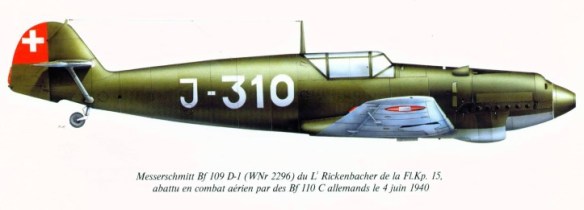Note that three Ju 52/3mg4e aircraft were delivered to the Swiss air force for transport work, and two of these were still on active strength in 1983, with the third preserved for a museum.
When the Swiss federal government formally recognized the existence of an air force in 1925. Over the following 15 years, air force officers (lobbying through their association, AVIA), convinced the Swiss parliament to approve a budget to buy the necessary aircraft to renew the fleet. By 1933, 40 Fokker CVs and 65 Dewoitine D-27s were in service. The air force’s strategy, however, remained focused on reconnaissance, thereby hindering the use of the new weapon as a guardian of Swiss neutrality. Thus, when Germany began sending troops and aircraft to Spain to fight in the civil war, no interceptions of the machines over Swiss airspace ever took place. No plans were made, however, to supply Switzerland with fighters until 1938, when the government acquired a license to manufacture Morane-Saulnier 406 aircraft. In addition, Messerschmitt Bf 109Ds and -Es were ordered.
In World War II, the Swiss air force used its meager resources to guard national airspace, intercepting and shooting down several German aircraft. However, Switzerland’s awkward position of economic dependency on Nazi Germany led some Swiss officials to condemn these actions and to end air patrols against any incursions of fewer than three aircraft. Confrontations with Allied aircraft also occurred, leading to the interception and capture of lost bombers (more than 100 B-17s and B-24s).
The Luftwaffe had 946 operational Me-109s when Germany invaded Poland on September 1, 1939. In addition, some 300 Me-109Es were exported to Switzerland, Yugoslavia, Romania and Spain between April 1939 and April 1940. Three Me-109E-3s were also shipped to Japan for evaluation early in 1941. The Japanese soon abandoned the idea of producing Emils under license, but the Allies took the possibility seriously enough to give the “Japanese Me-109” the code name “Mike.”
Two of the export orders were to cause some embarrassment later. In May 1940, three Heinkel He-111s that had strayed into Swiss airspace were shot down by Swiss-flown Me-109Es. Reichsmarschall Hermann Göring reacted by deliberately sending France-bound bomber formations over Switzerland with an escort of Me-110s. The clashes that ensued resulted in the loss of seven more German and three Swiss aircraft, after which Göring prudently relented.
Neutral Switzerland acquired 12 Me-109G-6s as part of a deal for destroying an Me-110G-4/R7 equipped with the latest Liechtenstein SN-2 radar and oblique-firing Schräge-Musik 20mm cannons, after the night fighter had accidentally landed at spy-infested Dübendorf on April 28, 1944. The Gustavs, and two other Me-109Gs that were interned after straying into Swiss airspace, were assigned to Fliegerkompagnie 7, but they were unreliable due to deteriorating German production standards at that point in the war, and saw little use.
Switzerland purchased both Doras and Emils before the outbreak of war, and used them in several furious dogfights with the Luftwaffe over incursions during the invasion of France, with the Luftwaffe losing a handful of He 111s and Bf 110s to the loss of a few Swiss Bf 109s.
Despite these incidents, the Swiss obtained a number of Gustavs late in the war. An Me 110 night fighter, carrying sophisticated electronics and armament, strayed into Swiss airspace in late April, 1944, and landed near Zurich due to engine trouble. The Germans bargained with the Swiss to sell them twelve Bf 109Gs under the condition that they burn the Me 110.
Later in the war Swiss Bf 109s were to intercept Allied bombers that strayed into their airspace, forcing them to land and be interned. There were rarely problems, but while escorting a B-24, a USAAF P-51D shot down one Swiss Bf 109 and damaged another. The Swiss tried painting their Bf 109s with loud red and white stripes to emphasize the Swiss cross markings, but this was discontinued because then the Luftwaffe mistook them as Allied aircraft painted in invasion stripes.
The Swiss Bf 109s were to serve after the war, only being scrapped in 1949.
#
Here is a list out of a report of the Swiss air force about German planes, landing or crashing on Swiss territory from December of 1944:
17th of December 1944, Me109G, 1 pilot, landing at Affeltrangen /
26th of March 1945, Me109G, 1 pilot, crashed at Farnern /
12th of April 1945, Bь181, 1 pilot, landing at Buerglen /
18th of April 1945, Bь181, 1 pilot and 1 male passenger, landing at Duebendorf /
20th of April 1945, Me108, 1 pilot, 1 male and 1 female passenger, landing at Payerne /
25th of April 1945, Me262, 1 pilot, landing at Duebendorf /
26th of April 1945, Fw44f, 1 pilot, landing at Duebendorf /
26th of April 1945, Bь181, 1 pilot, landing at Oberriet /
26th of April 1945, Bь181, 1 pilot and 1 male passenger, landing at Oberriet /
27th of April 1945, Me108, 1 pilot and 3 passengers, landing at Emmen /
30th of April 1945, Ju88, 1 pilot, 2 male and 3 female passengers, landing at Duebendorf/
2nd of May 1945, Siebel 204, 2 pilots and 3 passengers, landing at Belp /One of the passengers of that Siebel 204 was the Grand Mufti of Jerusalem, if I recall it right
8th of May 1945, Fieseler-Storch, 1 pilot and 2 passengers, landing at Chur /
Some Details about the landing of the Ju88 on the 30th of April: The plane, a night-fighter version of the Junkers 88, number 623 211, started at 01.30 CET at Lubeck/Northern Germany, with the intention to reach Switzerland. It was landing on the Dubendorf military airfield at 05.15 CET with 6 people aboard (1 Captain, 2 second lieutenants, 1 woman, 1 pregnant woman, 1 six years old girl). The male passengers were arrested by a section of Swiss infantry, the female passengers were handed over to the Swiss Red Cross.
